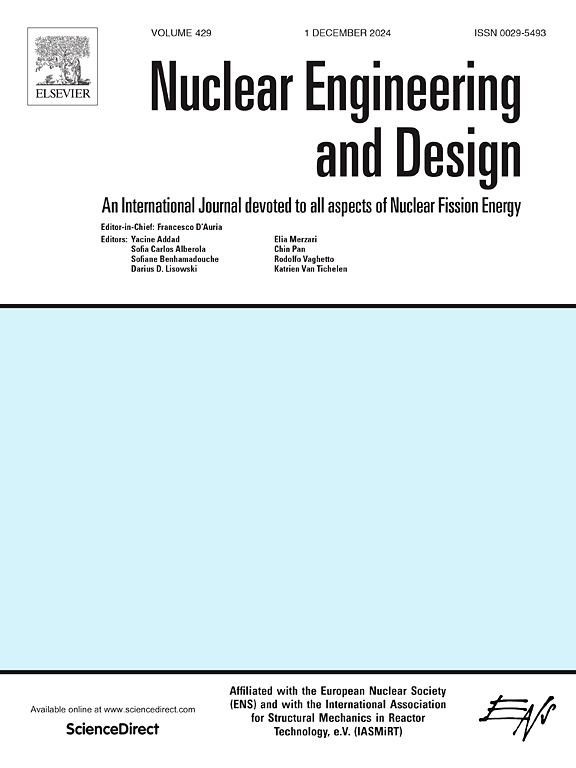Small modular reactors and the transition to renewable energy
IF 1.9
3区 工程技术
Q1 NUCLEAR SCIENCE & TECHNOLOGY
引用次数: 0
Abstract
Since the operation of nuclear reactors does not emit any carbon dioxide in the atmosphere, nuclear energy may significantly contribute to the decarbonization of the electricity generation industry. Small modular reactors can be parts of the local mini- and micro-grids that are touted to power in the decarbonized future local communities in combination with the highly diffused solar and wind power. Such a micro-grid, serving the equivalent of 50,000 buildings, is studied for the region of North Texas. The power demand of this community is satisfied by the combination of SMR, wind turbines, and photovoltaics. A hydrogen-based energy storage system is used to ensure that sufficient power is always available. With the known electric power and heating demand of the entire community, calculations are performed to match the energy supply and demand for all the hours of the year. Two cases are studied: a) when only the electric demand is supplied by the non-carbon sources; and b) when both electricity and the heating requirements of the community are supplied. Addition of nuclear power in the renewable energy mix significantly reduces the required nominal solar and wind power capacities with substitution factors in the range 2.7 to 7.0 MW per MW of installed nuclear capacity. The required energy storage capacity in the hydrogen system also drops by about 39 % in case (b).
小型模块化反应堆和向可再生能源的过渡
由于核反应堆的运行不会向大气中排放任何二氧化碳,核能可能对发电行业的脱碳做出重大贡献。小型模块化反应堆可以成为当地微型和微型电网的一部分,这些电网与高度分散的太阳能和风能相结合,被吹捧为脱碳未来当地社区的电力。这样一个微电网,服务于相当于50,000栋建筑,正在为北德克萨斯地区研究。该社区的电力需求通过SMR,风力涡轮机和光伏发电的组合来满足。一个基于氢的能量存储系统被用来确保足够的电力总是可用的。根据已知的整个社区的电力和供暖需求,进行计算以匹配全年所有时间的能源供应和需求。研究了两种情况:a)仅由非碳源提供电力需求;b)当社区的电力和供暖需求都得到满足时。核电在可再生能源结构中的加入显著降低了所需的名义太阳能和风能发电能力,每兆瓦装机容量的替代系数在2.7至7.0兆瓦之间。在(b)情况下,氢系统所需的能量存储容量也下降了约39%。
本文章由计算机程序翻译,如有差异,请以英文原文为准。
求助全文
约1分钟内获得全文
求助全文
来源期刊

Nuclear Engineering and Design
工程技术-核科学技术
CiteScore
3.40
自引率
11.80%
发文量
377
审稿时长
5 months
期刊介绍:
Nuclear Engineering and Design covers the wide range of disciplines involved in the engineering, design, safety and construction of nuclear fission reactors. The Editors welcome papers both on applied and innovative aspects and developments in nuclear science and technology.
Fundamentals of Reactor Design include:
• Thermal-Hydraulics and Core Physics
• Safety Analysis, Risk Assessment (PSA)
• Structural and Mechanical Engineering
• Materials Science
• Fuel Behavior and Design
• Structural Plant Design
• Engineering of Reactor Components
• Experiments
Aspects beyond fundamentals of Reactor Design covered:
• Accident Mitigation Measures
• Reactor Control Systems
• Licensing Issues
• Safeguard Engineering
• Economy of Plants
• Reprocessing / Waste Disposal
• Applications of Nuclear Energy
• Maintenance
• Decommissioning
Papers on new reactor ideas and developments (Generation IV reactors) such as inherently safe modular HTRs, High Performance LWRs/HWRs and LMFBs/GFR will be considered; Actinide Burners, Accelerator Driven Systems, Energy Amplifiers and other special designs of power and research reactors and their applications are also encouraged.
 求助内容:
求助内容: 应助结果提醒方式:
应助结果提醒方式:


